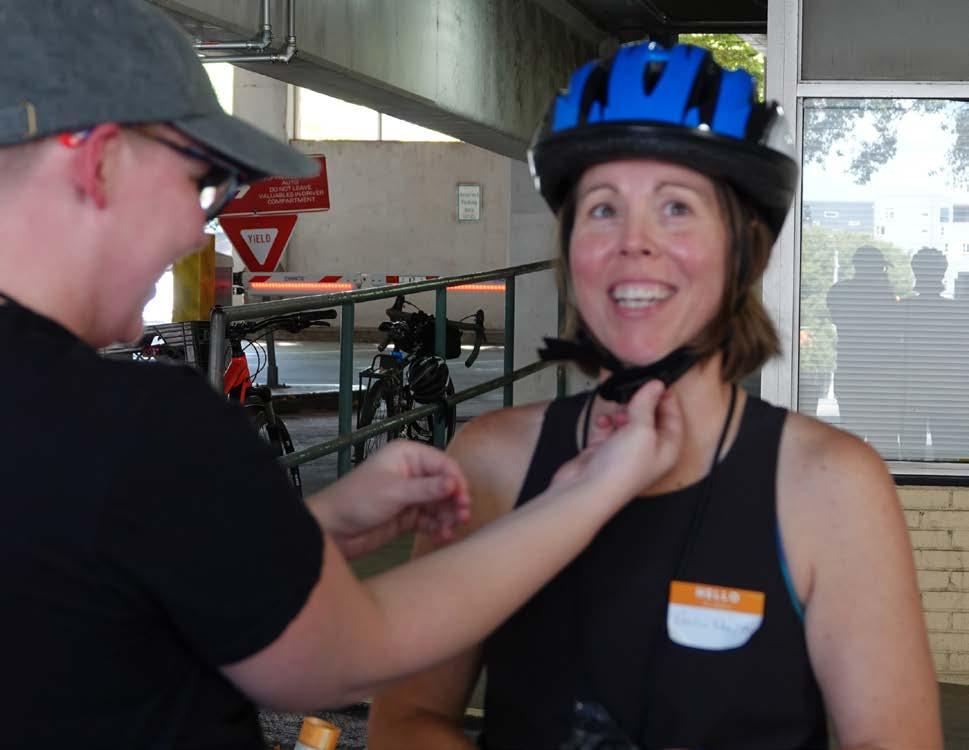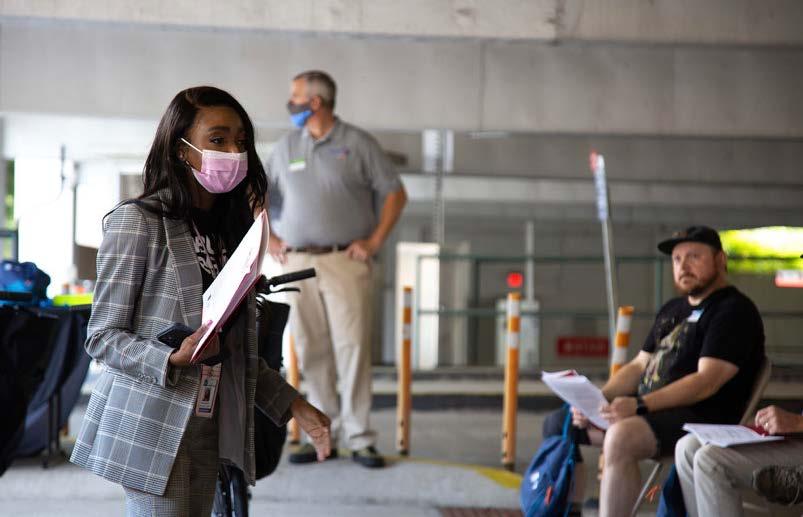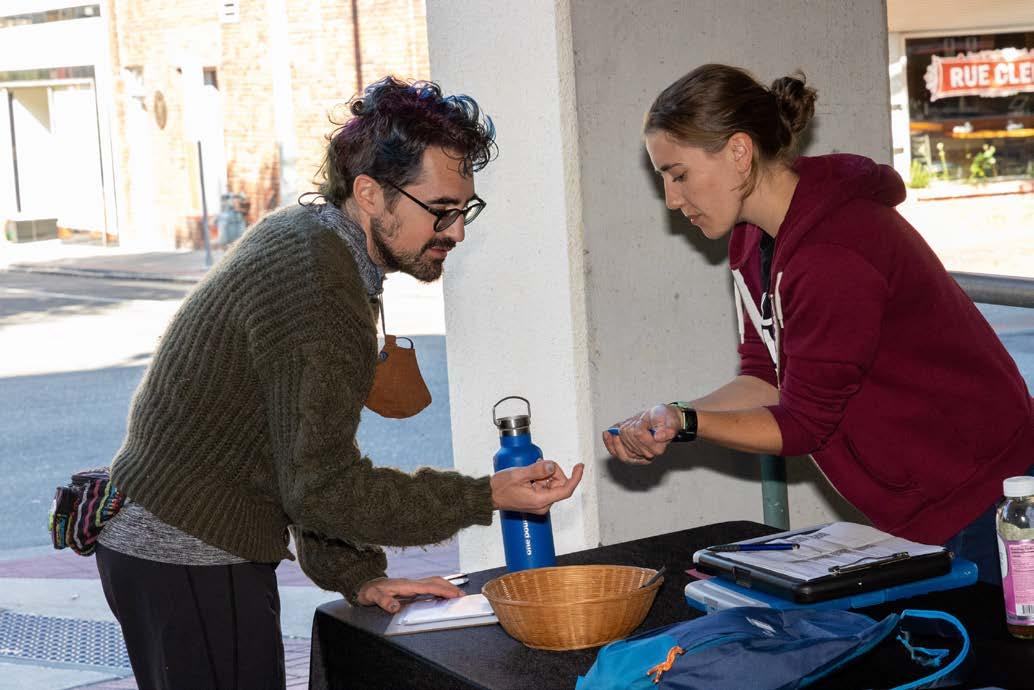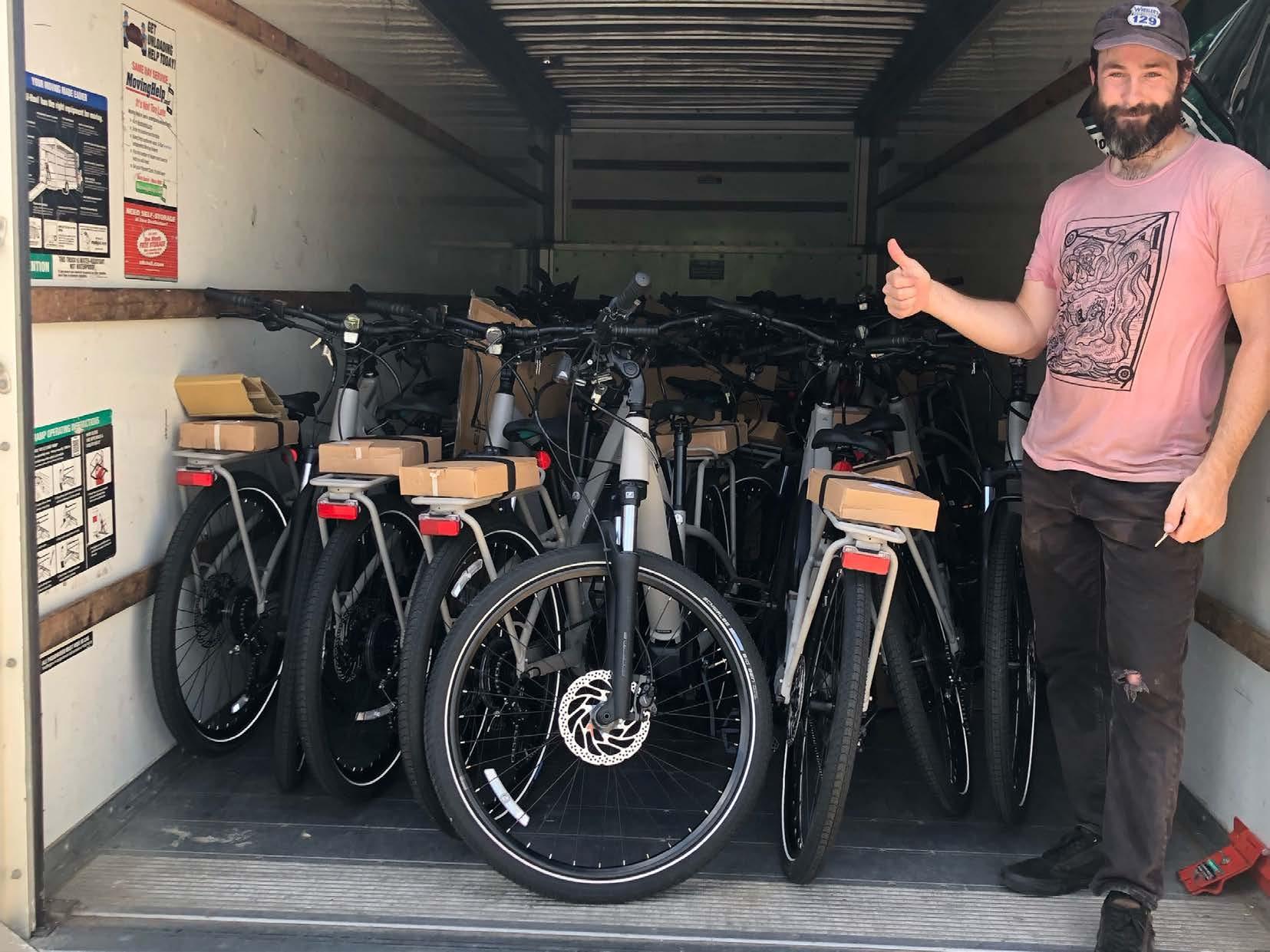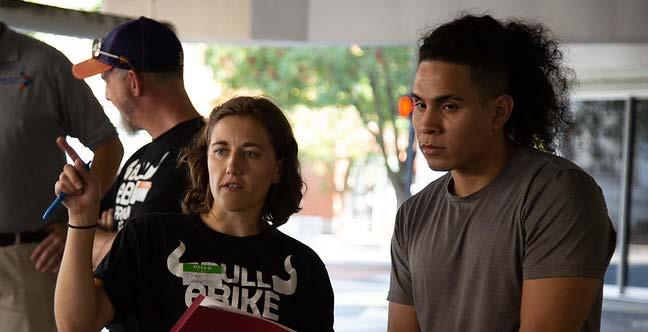Durham Bull E-Bike Implementation Guide


$1M GRANT



$1M GRANT
In 2018, Durham was declared a winner of the 2018 Bloomberg Mayors Challenge (BMC) and was awarded a $1 million grant to combine Transportation Demand Management practices with Behavioral Sciences to reduce drive alone trips in downtown Durham.
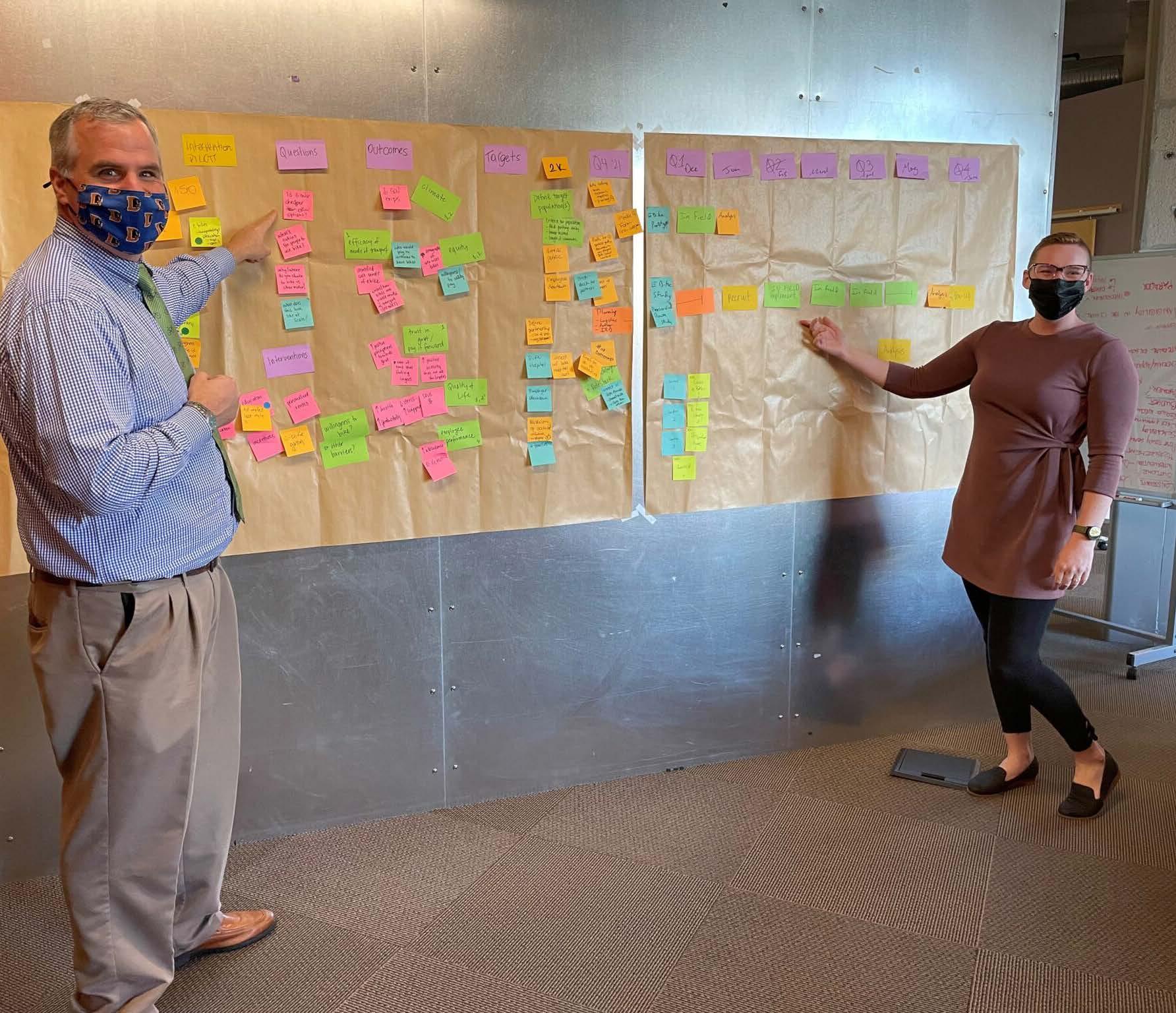
The overarching goal of the Mayors Challenge is to develop innovative strategies that can be tested at a local level, but expanded to solve global problems. The team used behavioral science, human centered design, and rigorous evaluation to launch several successful pilot programs. The pilots included exploring personalized routes, bus lottery, carpooling, micromobility, and parking purchasing interventions. More information about those pilots can be found here
In its final pilot, the City evaluated the potential of an equity based e-bike program, which ultimately led to the Bull E-Bike Pilot Program. By sharing challenges, lessons learned and successes from the Bull E-Bike Pilot, the City of Durham hopes this guide will be a tool for other jurisdictions to explore and implement innovative transportation demand management and equity based e-bike programs.
“E-bikes” is a broad term that covers a range of battery-powered bicycles. The battery assists the bicyclist, typically, by either adding a boost “assist,” activated via pedaling, or through a throttle.1 E-bikes allow users to travel distances and terrains with less effort (and sweat!) than traditional bicycles.
Additionally, e-bikes can allow people with mobility issues to travel by bicycle without the physical demands of a traditional bicycle.
The discussion of e-bikes derived from the City’s collaboration with a non-profit organization that builds digital transportation infrastructure. The alignment of organizations permitted the use of hundreds of e-bikes acquired from a private micromobility company. Due to concerns over the liability and risk management for insurance and indemnification, the City quickly decided in May 2022 to use some of their remaining grant funding to purchase 49 e-bikes to ensure an on time pilot project launch. After intensive research, procurement processes, in-depth community focus groups, canvassing downtown Durham, and roughly two weeks of assembling the first 30 of these e-bikes, the Bull E-Bike Pilot program officially began on August 15th, 2022.
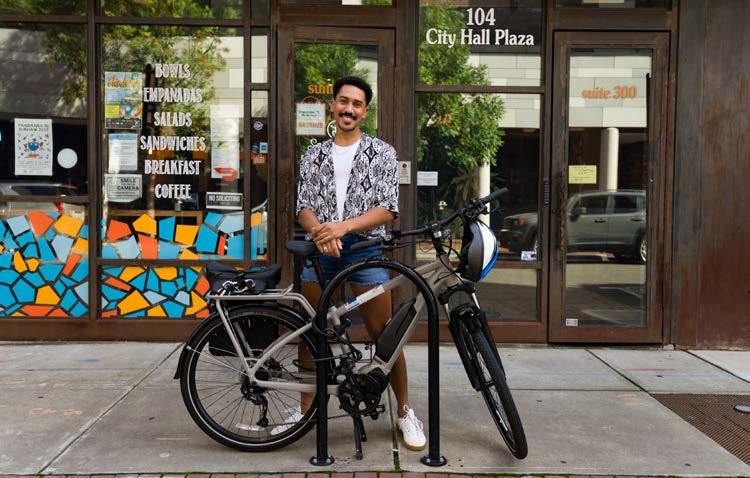
The program was designed to identify how e-bike infrastructure can reduce single-occupancy vehicle commuting and improve mobility for shift workers in downtown Durham who experience transportation disadvantages. Priority was given to shift workers because of the Mayor’s Challenge commitment to innovation and the City’s shared value of equity. The team used advanced technology, human centered design, and specific outreach strategies to give voice to shift workers- a group often left out of TDM research and design. The City partnered with Downtown Durham Inc. to identify the businesses that makeup the downtown business industry and would be the most receptive to partner with this project. All participants were required to work within downtown to ensure everyone had access to the centrally located service center for bike maintenance and to fulfill the grant requirement to reduce drive alone trips downtown.

Our team developed a strategic marketing, outreach, and communications plan that identified the key areas where we could connect with this population in an engaging and

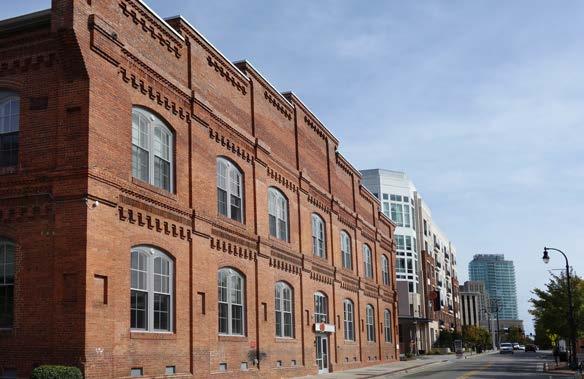
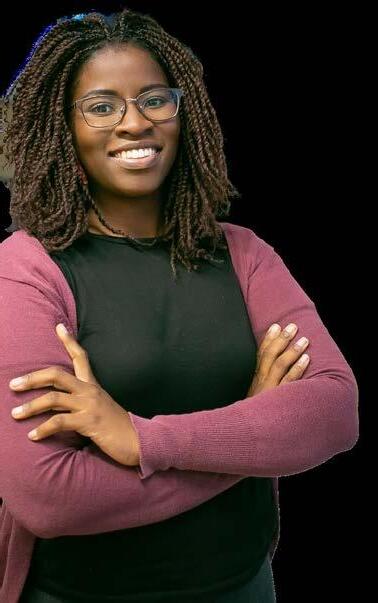
impactful way. First, we led personto-person and business-to-business canvasing by working with employers and managers to communicate with workers in the hospitality industry. Secondly, we supplied business owners with bilingual print flyers and digital communications to attach to employee paychecks and internal communications.
Our team also placed an e-bike across popular transit stops between businesses with posters attached explaining more about the program and how to apply. Additionally, we placed advertisements in GoDurham buses, where the vast majority of GoDurham transit riders represent lower-income and minority populations and rely on our transit system as their only method of transportation. The advertisements were available in English and Spanish and connected the riders to the Bull E-Bike website with a QR code to learn more about the program and to apply.
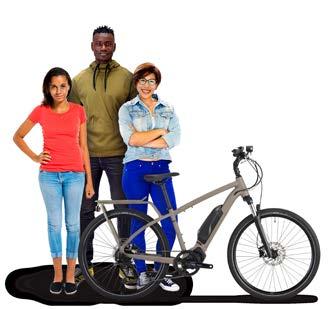

The City provided e-bikes to seven cohorts with an average of 10 participants for an average of four weeks each. Each orientation provided participants with their bike and other biking essentials such as a helmet, lights, safety vest, waterproof cargo bag, phone holder, etc. Each person received a custom fitting of their bike and helmet, a personalized route plan from their home to work location, inperson road rules education, and a tutorial on how to use the commute tracking app.

The pilot program started on August 15 and concluded on November 7.
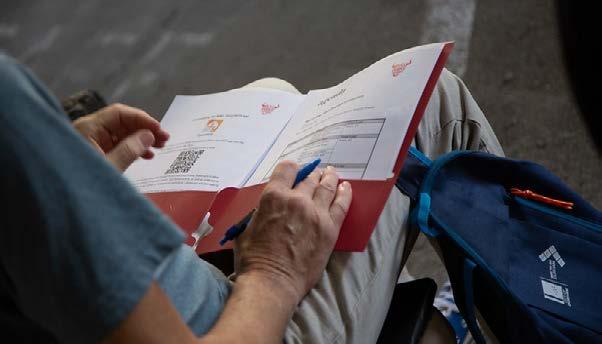

Prior to launching the Bull E-Bike Pilot, the City of Durham conducted a research phase lasting several months, which led them to connect with other e-bike programs in the U.S. and internationally. Two successful models the team used as inspiration are in Canberra, Australia and Denver, Colorado.
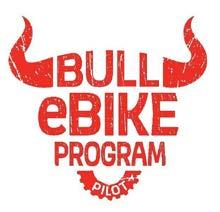
The Canberra Electric Bike Library launched a temporary e-bike loan program for residents. For this program, residents pay only the cost of Pedal Power insurance ($35 for an individual or $50 for a household) and can check out an e-bike for 14 days.
The Can Do Colorado eBike Program in Denver provided e-bikes to low-income essential workers across the region. This program utilized a previous version of the National Renewable Energy Laboratory’s (NREL) OpenPATH mobile app to measure metrics such as trip mode, trip distance, and trip purpose, among others. This provided the foundation for the partnership that the City of Durham would build with NREL to further expand their mobile app through implementation with the Bull E-Bike Pilot program. More on this partnership in Section B.
Ultimately, the City’s pilot analyzed how electric bikes may be deployed in Durham – through piloting a combination of new methods and methods tested elsewhere and –and to improve the transportation experience in Durham. Through the experiences of the pilot participants, the Bull E-Bike Pilot demonstrated that e-bikes are a safe, efficient, and healthy way to travel around Durham and reduce drive alone behavior.
The City used a pilot structure for this program – a short-term “test” that is designed to help learn how larger-scale projects might work to achieve longterm goals.
A focus of this program was transportation equity – providing increased economic and transportation mobility by reducing the barriers to e-bike adoption for shift workers.
The City designed the pilot to measure Health, Financial, Independence, and Environmental outcomes.
Additionally, these outcome measures apply an Equity lens to the pilot analysis. The City of Durham will use these measurables, as well as indicators on program function and operations, to launch a second phase of the Bull E-Bike Program in the future (See recommendations in Conclusion Section).
The Bull E-Bike Pilot Program used Key Performance Indicators (KPIs), or specific data, to track progress on program objectives. The KPIs are broken down into qualitative and quantitative data. Quantitative data is numbers-based (i.e. how many times per day did User A ride the e-bike) and comes from tracked data sources, while qualitative data is non-numerical (i.e. how likely is User A to continue using an e-bike after the pilot) and comes from sources like interviews and surveys. The full list of KPIs for this pilot is available in the Appendix.
Prior to launching the pilot program, the City of Durham undertook a market study to help determine the demand for e-bikes and inform the design of the pilot. At the time, the City had an idea that it would launch a program with 150-200 bikes, and that the program would focus on downtown workers. The pre-pilot support research found that there are between 700 and 1,500 downtown workers who currently drive alone, live within five miles, and are interested in biking.In focus groups led by the engagement partner, Bike
The recommendation for a multi-week design emerged from the focus groups and other engagement activities, with the determination that a shorter program, or a longer program, would require more significant incentive structures for participant engagement and data reporting. Through this recommendation, the City of Durham used a four-week baseline cohort model for the pilot.
Durham, 60% of downtown shift workers were driving alone to work, which led to challenges with parking, among others.
Due to the trend and the lower availability of e-bikes, the City of Durham saw the potential to reach a larger number of workers by using a cohort model. This model would increase the amount of data the City is able to collect during the pilot, thus establishing a stronger, data-informed basis for any subsequent phases of the Bull E-Bike Pilot Program.
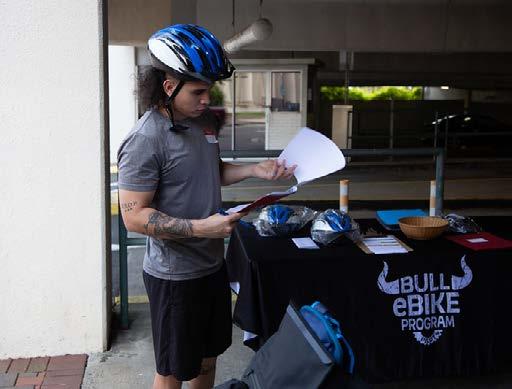
At the end of each cohort, the City identified “super-users” and extended the e-bike loan for these users for up to an additional eight weeks. A total of 12 super-users were identified. The City classified “super-users” based on (a) the completion rate of weekly check-in surveys, (b) trip confirmation rate within the NREL mobile app, and (c) the level of communication between participants and program administrators. The City decided to provide the super-users extended time with the e-bikes because the team wanted to continue identifying patterns of changed travel behavior from participants who showed extreme usefulness of the e-bike.
During their orientation, all participants received information about program expectations, including the importance of the weekly check-in surveys, trip confirmation, and regular communication.
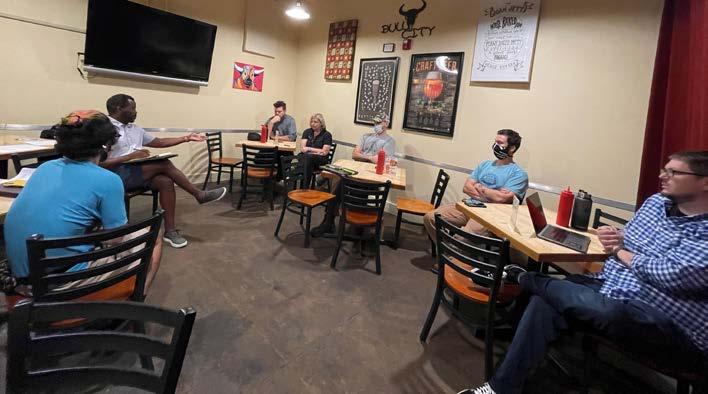
Participants in the Bull E-Bike Pilot Program were required to use the OpenPATH mobile app to submit data on their trips. The app works on iOS and Android devices and provides insight into travel habits, mode switching, and emissions reduction trends. Program participants without access to a smart device would have had one purchased for them, though all 61 selected participants in the program did have existing access to a smart device.
The app passively tracked trip information, but participants were required to open the app to “confirm” the data that the app had collected.
With each confirmation, the app built a better picture of participant travel habits and learned typical travel choices. No personal identification information (PII) collected through this program will ever be shared outside of program
administration. The secure data collected via OpenPATH was critical to the successful evaluation of the pilot.
Participants also completed a benchmark survey at the beginning of their participation, weekly surveys throughout, and an exit interview at the end of their participation. Participants were asked questions about their confidence on a bike, their motivations, the benefits and challenges of the e-bike, and program feedback. These interviews were coded and analyzed to identify themes. The qualitative data collected through the semi-structured interviews complemented the quantitative data collected via OpenPATH to build a more complete evaluation of the pilot.
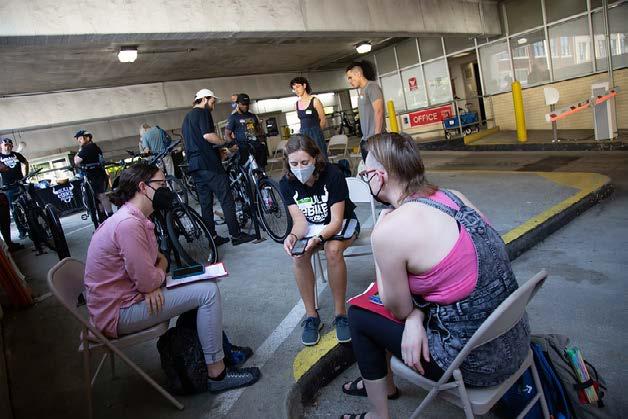

For Spanish-speaking participants, the OpenPATH app automatically translated into Spanish text. The City worked with the equitable engagement team for translation services at orientation, check-ins, and exit interviews. The team quickly built trust with the two Spanishspeaking participants which helped increase comfort with the pilot program.
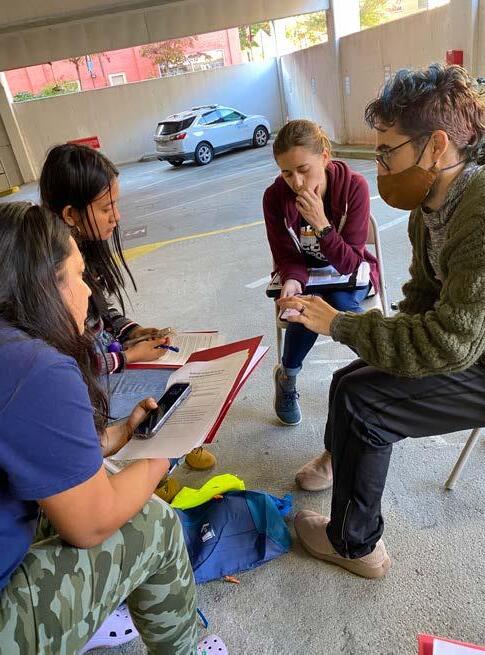
The City of Durham’s Department of Transportation has been the primary program administrator for all programs funded by this grant, including the Bull E-Bike Pilot Program. The pilot has seven key partners in engagement and outreach, data collection and analysis, bike maintenance, and promotion.


Bike Durham
Bike Durham is a local non-profit organization that believes everyone should have access to safe, affordable, and sustainable transportation regardless of who they are or where they live. After the Request for Proposal (RFP) process and several interviews, the City of Durham hired Bike Durham as the equitable engagement consultant. Between their commitment to bicycle equity and their knowledge of the community, Bike Durham was an important partner in the equitable creation and delivery of the pilot.
Bike Durham’s key responsibilities included recruiting and facilitating focus groups for the City’s target population, creating an engagement report with recommendations for the pilot program (see Appendix), and assisting with participant recruitment for the pilot.
Downtown Durham, Inc.
Downtown Durham, Inc. (DDI) is a non-profit organization that works to enhance the environment, economy and vitality of downtown Durham, while preserving and enriching its distinctive culture and strong sense of community.

DDI’s primary role as a partner was program promotion and recruitment, including relaying City of Durham communication through their employer channels. With the pilot’s focus on downtown Durham shift workers, DDI was an important partner in establishing trust and sharing their extensive knowledge of downtown businesses. The City used the DDI Map as the pilot’s downtown boundary for the purposes of this pilot.
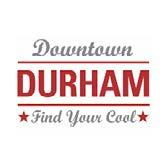
National Renewable Energy Laboratory
National Renewable Energy Laboratory (NREL) advances the science and engineering of energy efficiency, sustainable transportation, and renewable power technologies and provides the knowledge to integrate and optimize energy systems.5
NREL developed the CanBikeCO mobile application for the Can Do Colorado eBike Mini Pilot in 2020.6 The City of Durham and NREL entered into a Memorandum of Understanding (MOU) to deploy the OpenPATH mobile app for the pilot. With participant permission, this app, OpenPATH, gathered passive information about participant travel and, user-input data and feedback about their trips. The data collected through this app was useful for the evaluation of the pilot program and development of future programming.
The Department of City and Regional Planning (DCRP) is an American Planning Association-accredited educational institution at the University of North Carolina (UNC) at Chapel Hill. The City contracted second-year graduate students in the master’s degree program at DCRP to support the pilot’s quantitative and qualitative data analysis. DCRP’s key responsibilities included:
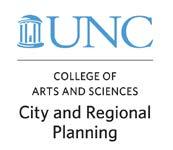
★ Gathering qualitative data from participants through exit interviews
★ Aggregating anonymous quantitative data collected through the OpenPATH mobile application
★ Measuring collected data against the Key Performance Indicators (KPIs)
★ Issuing a final report summarizing key findings and recommendations for the future of the Bull E-Bike Program
The pilot e-bikes were assembled by mechanics at REI (see next section). The City of Durham hired a mechanic for on-call maintenance, research, education and support throughout the pilot. He had worked as a bicycle mechanic for nearly twenty years, most recently as the senior mechanic and sales representative at an established, independently owned bicycle shop in Downtown Durham.
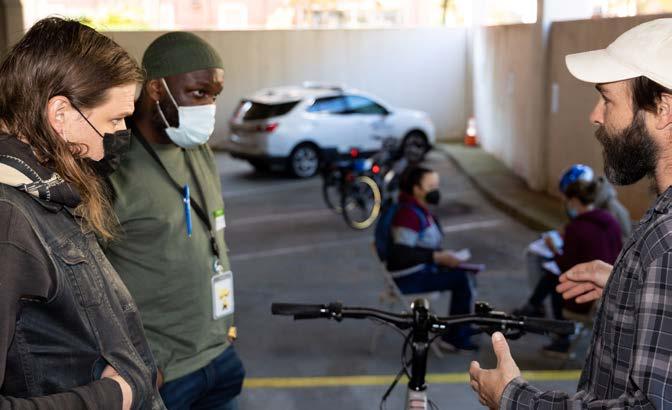


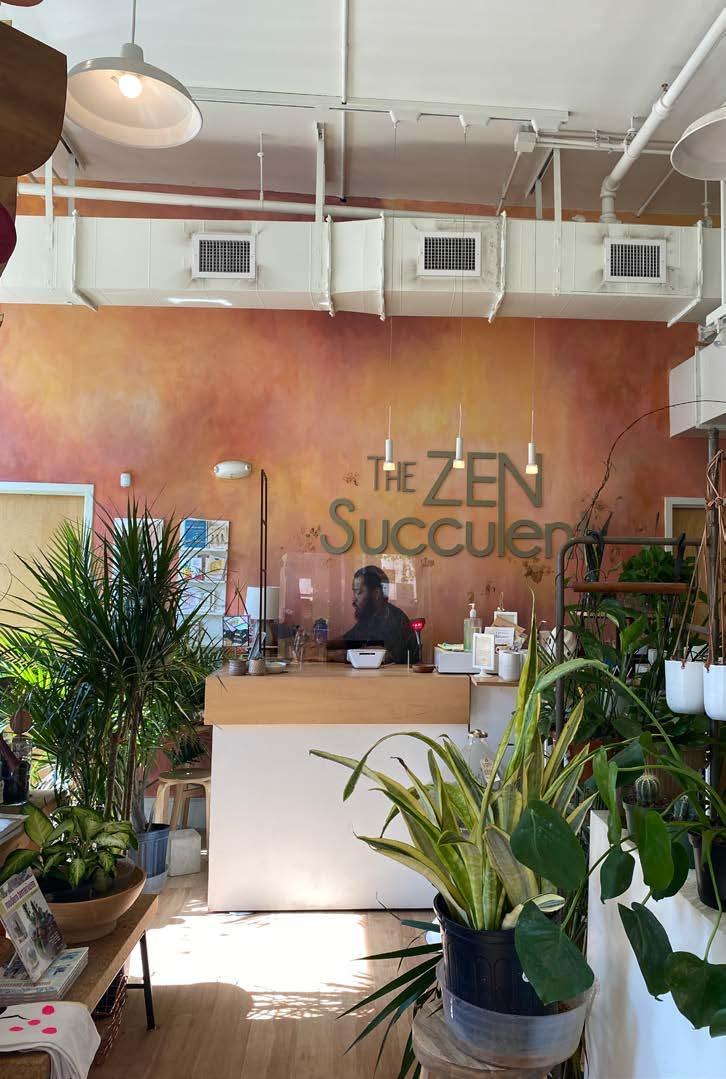
Shift Up Media is a marketing agency for sustainable transportation businesses and programs. The City of Durham hired Shift Up Media to create promotional and educational videos. In total, Shift Media created multiple videos: one to teach pilot participants about bike safety and road rules, and three with pilot participant testimonials. GoDurham


GoDurham is Durham’s transit agency offering safe, reliable, convenient and accessible passenger transportation. The City of Durham promoted the pilot with print and install advertisements on the inside of all 55 GoDurham buses.

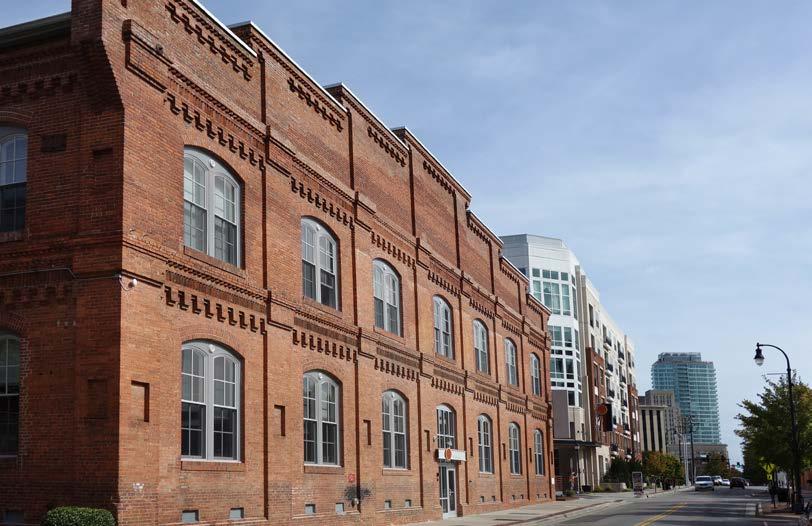


The Bull E-Bike Pilot was the most expensive project completed in the 4-year BMC grant cycle. With the majority of the work completed in-house, the City used just over 50% of the funds on personnel cost, and roughly 30% on the e-bikes and accessories. See a full budget breakdown below.
ITEM ROLE/TASKS
2 Full-Time City of Durham Personnel & 2 Part-Time Personnel (Mechanic and Project Coordinator)
Led program development, research, implementation, bike and equipment procurement, assembly, advertising, education, training and communications material development, participant selection, conducted orientations, weekly communications with participants, led data compliance and coordination.
TOTAL COST
$135,076.99
Contractors (equitable engagement, videography, graphic designers)
Led and recruited participants for focus groups, canvassed downtown businesses, supported program design, and Spanish translation support. Videography production. Graphic design for web and print materials.

$24,886.70
Equipment (e-bikes, accessories) 49 e-bikes, fenders, panniers, U-locks, helmet for each participant. $ 71,125.12
General Advertising $13,178.14
Total $244,266.95
City of Durham awarded $1MM Mayor’s Challenge grant over three years
Learned about Human Centered Design Process and started designing the project to align with it
Fall 2021
Bloomberg Mayor’s Challenge grant is extended until December 2022
E-bike and transportation research, conversations with e-bike professionals, pitched Bull E-Bike Pilot idea to Bloomberg
Virtual Town Hall supported by DDI sharing pilot idea with downtown business owners
Feb 2022
Began Request For Proposal (RFP) process working with the City of Durham’s Neighborhood Improvement Services Department for the pilot’s equitable engagement consultant team
Present Bull E-Bike Pilot concept to Mayor O’Neal
Begin conversations with NREL about project partnership
Downtown employer and employee “transportation needs” interviews
E-bike safety video finalized with Spanish subtitles
Pivoted project design to use new e-bikes
June 2022
Apr. 2022 Focus groups began through recruitment and hosted at different downtown businesses
(eg. Bull City Burger)
May 2022
Researched and procured 49 new e-bikes
Finished focus groups with a total of 40 downtown shift-workers
Pilot applications opened, marketing began for participant recruitment
June-July 2022
Pilot applications ongoing Received remaining 19 e-bikes
Additional mechanical work
New cohorts launched
Pilot design updated daily
Data collection
Participant feedback
Bike Durham and Shift Up
Media contracted
NREL Memorandum of Understanding signed
Data collection finished
Data analysis and report writing
Nov. 2022
Weekly check-in communications
Mechanical tune-ups
Exit interviews
Sep. - Nov. 2022
Received 30 e-bikes and started mechanical work
First cohort selected, notified, and launched
UNC-CH DCRP project kick-off
Aug. 2022
For the Bull E-Bike Pilot, the City used the REI Co-op Cycles CTY e2.1 Electric Bike. This e-bike was chosen for the pilot because of its availability of parts, shipment, and installation within the pilot’s timeline.
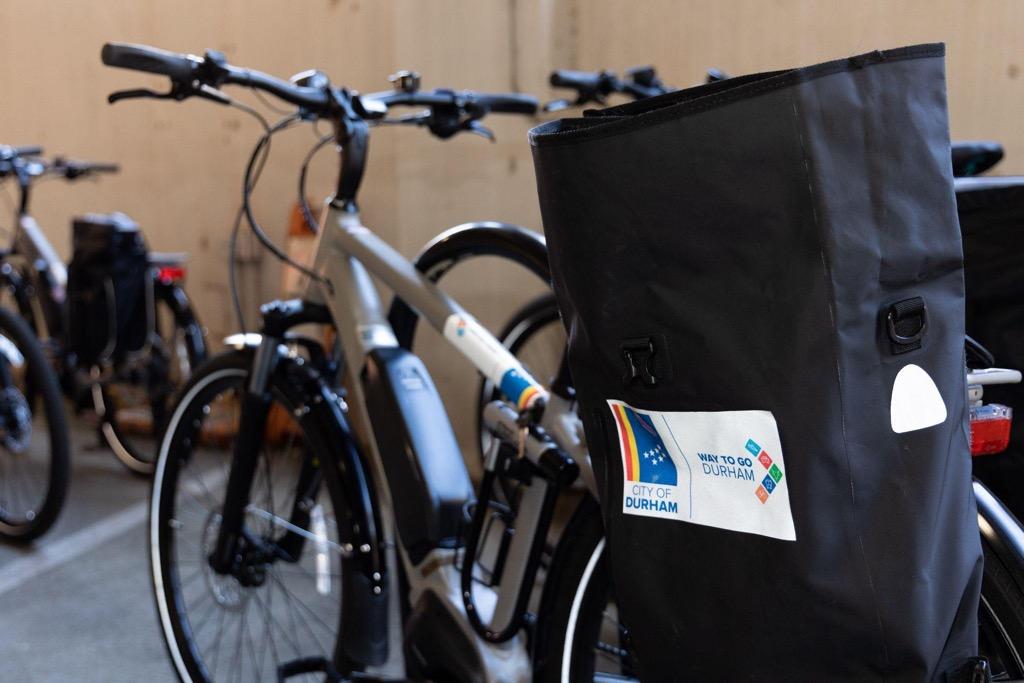
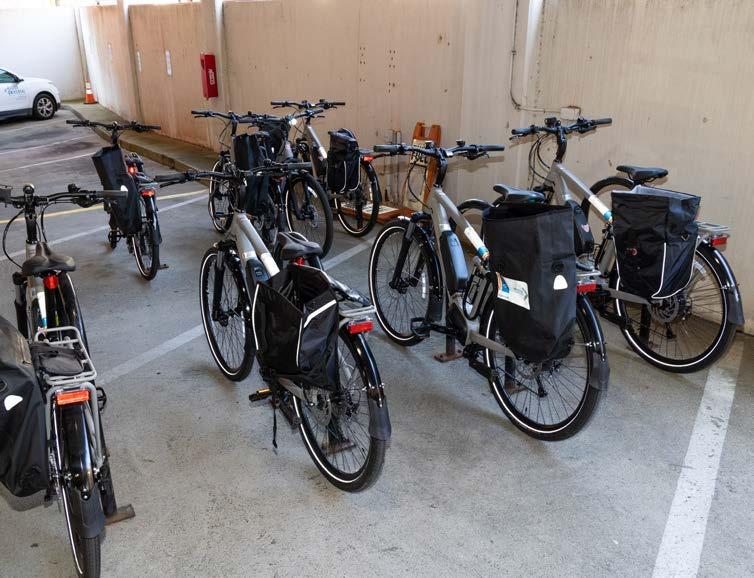

The Co-op Cycles CTY e2.1 is a Class 1 electric bike with a frame-mounted battery and an electric motor that provides pedal assistance for up to 20 miles per hour. It offers 3 pedal-assist modes and can provide pedal assistance for up to 50 miles with a single charge. More information regarding the e-bike’s maintenance and reported issues can be found here and in the Appendix.
Additional features of the e-bike include:
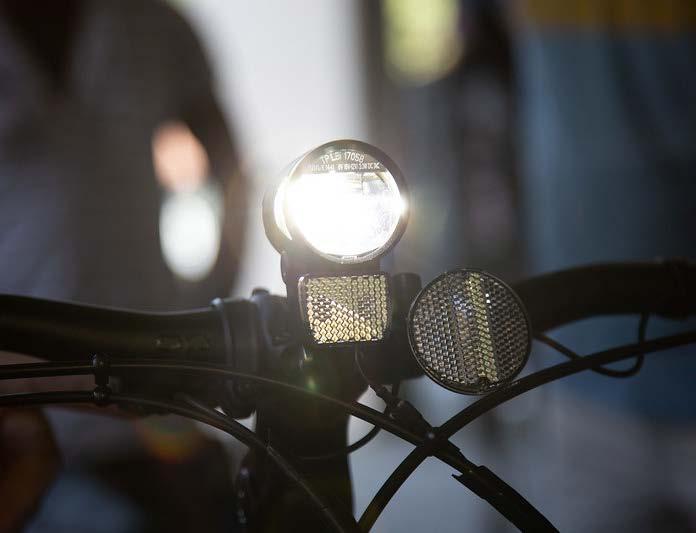
★ Front suspension fork to improve rider comfort
★ Integrated rear rack to facilitate grocery runs and itemcarrying
★ Nine gears to better adapt to changing speed and terrain
★ Hydraulic disc brakes to ensure rider safety in varying weather conditions
★ Metal front and rear fenders to help with riding in rainy weather
★ Water bottle holder to help riders stay hydrated
Apart from the e-bike, the City provided pilot participants with additional equipment and services that aimed to deliver a smoother, safer, and more accessible riding experience.
These items were identified from the focus groups the equitable engagement team conducted, and included:
★ Reflector
★ Front and rear bike lights
★ Neon yellow safety vest
★ Tire patch kit
★ Phone handlebar holder
★ Bike water bottle
★ Sweat towel
★ U-lock and a cable
★ 1 waterproof pannier (converts to a backpack)
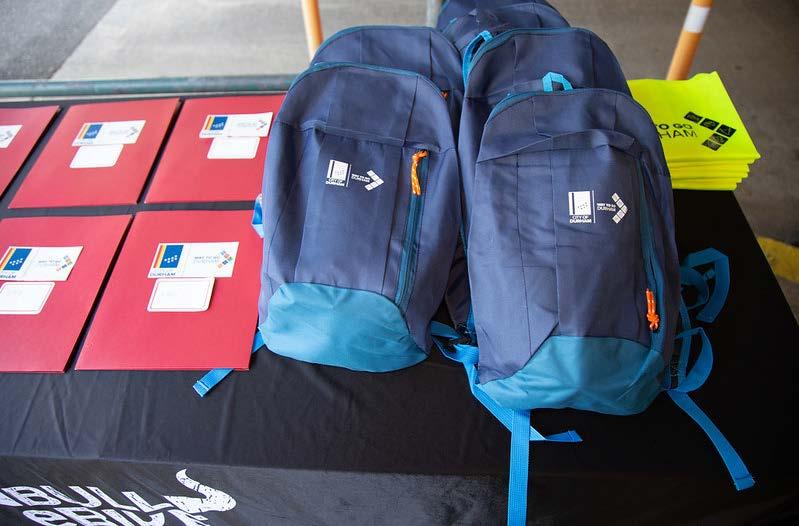
★ Emergency Ride Home program informational card
★ This program provided riders with a free taxi ride when they or their family members get sick, or when they have unscheduled overtime on days when commuting by e-bike
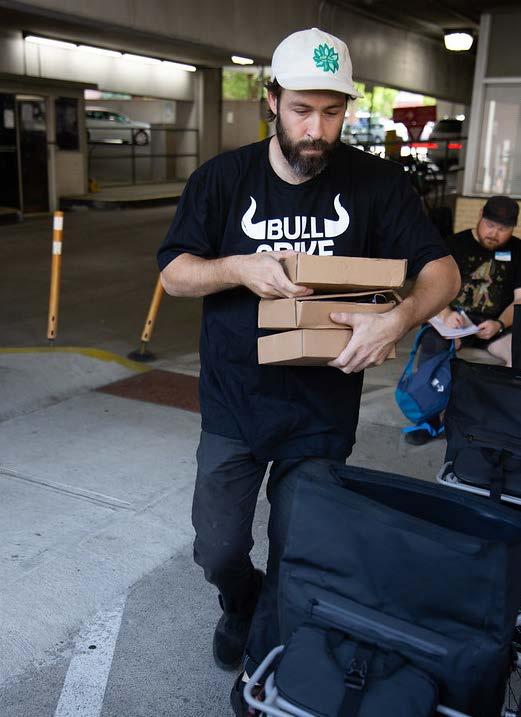
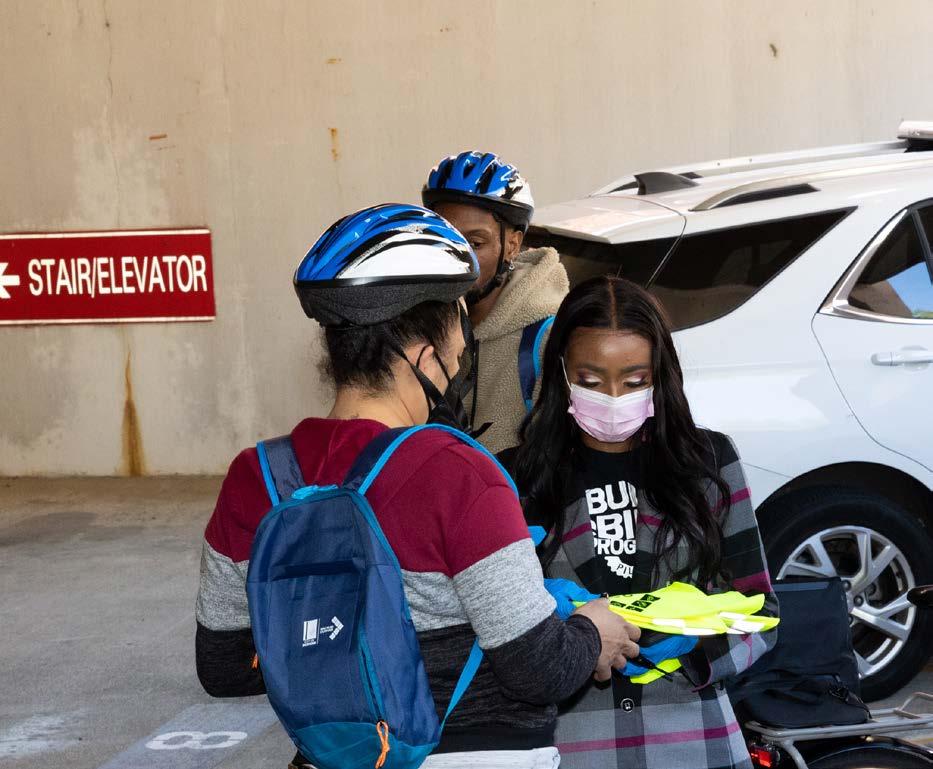
★ Way to Go Durham educational rack card
★ Servicing by a mechanic (additional information available in E-Bike Maintenance)
★ E-bike education provided in English and Spanish
• Personalized route to and from house
• In-person safety briefing on bicycling road rules
• Durham bike safety video
• Printed Durham Hike and Bike Map
• League of American Bicyclists road rules booklet
• Participant webpage including more safety and bike resources
The Bull E-Bike Pilot Program emphasized race, household income and gender identity as priority populations for this program. Eighteen percent of program participants report as nonbinary or gender non-conforming, and 11.5% of participants report being transgender.
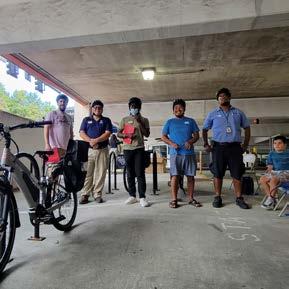

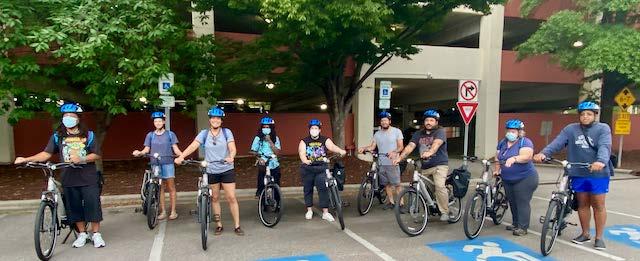
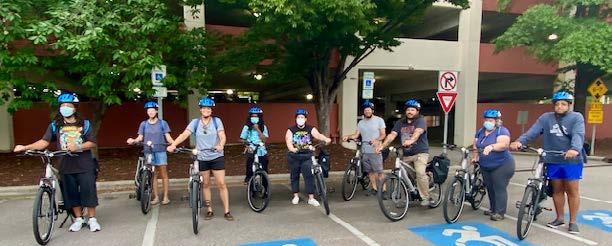
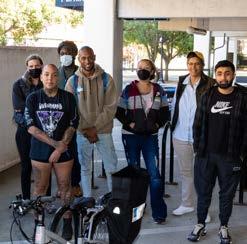
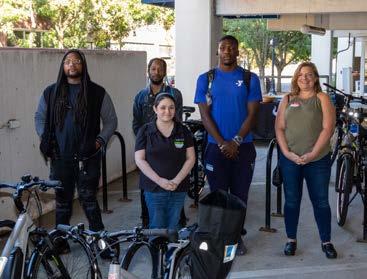

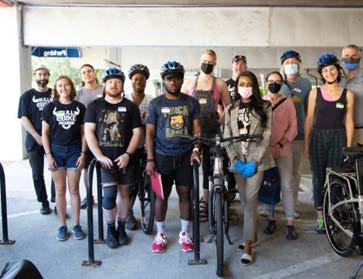
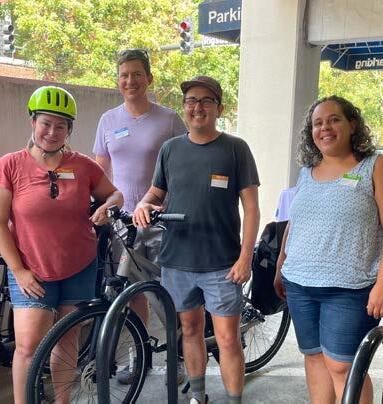
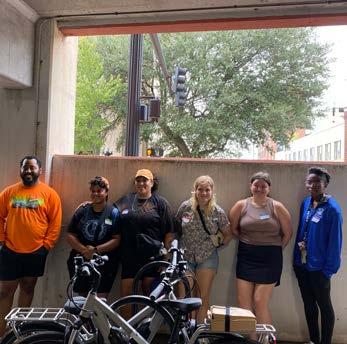
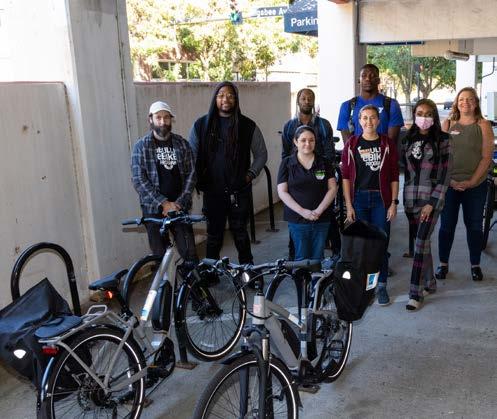
The median reported household size of pilot participants was two. The median reported household income of pilot participants was $40,000. This is 65% of the median household income for the City of Durham, according to 2020 ACS 5-Year Estimates.
“Sales or service positions” was the highest reported jobs, with 38% of pilot participants reporting working in this field, while 23% report working part-time jobs and 40% report working two or more jobs.
“Car (Drive Alone)” was the highest reported commute mode, with 48% of participants reporting they would typically drive alone (singleoccupant vehicle) to work. Only 11.5% of participants state they would typically bike to work

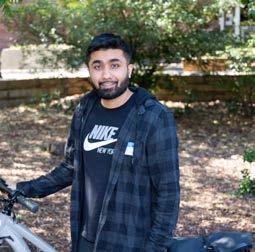
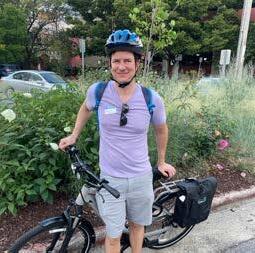
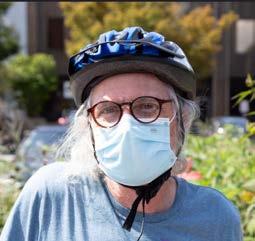

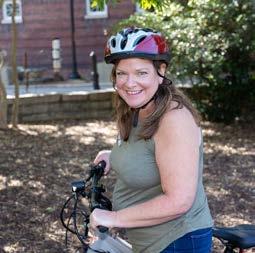

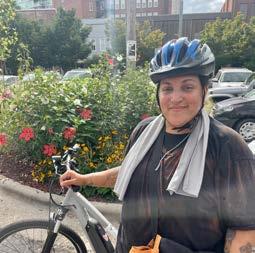
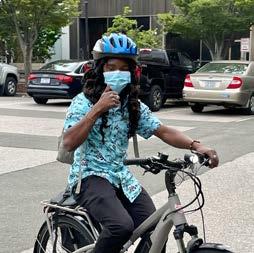
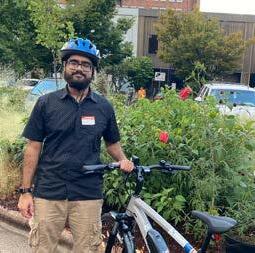
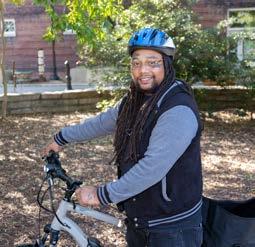










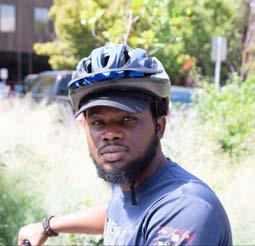


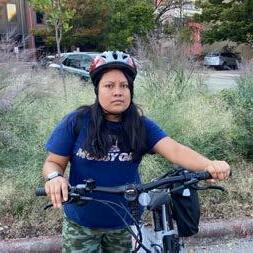


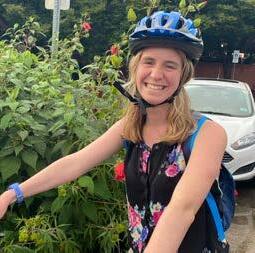
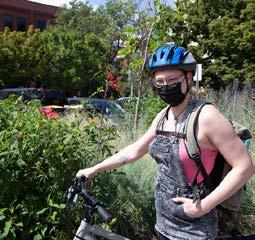
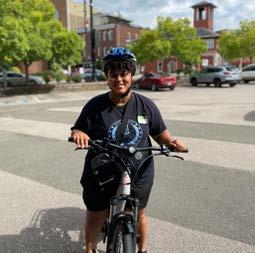

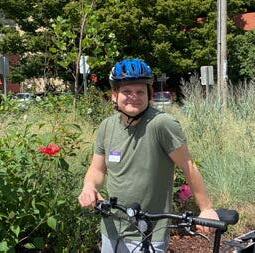
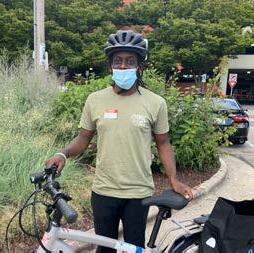
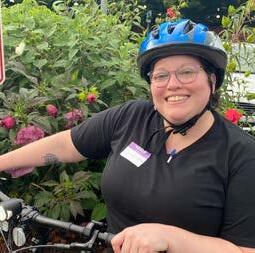

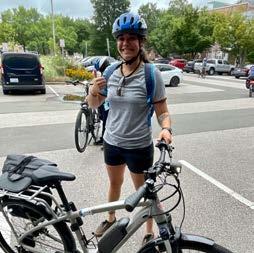


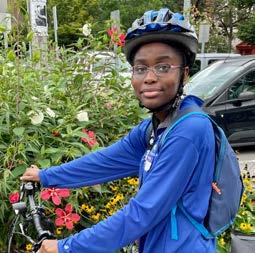
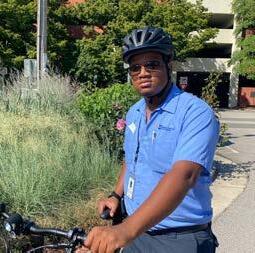
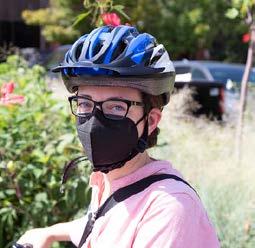
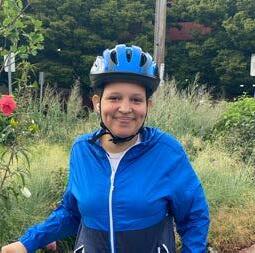
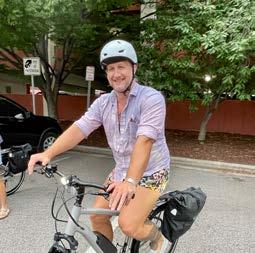
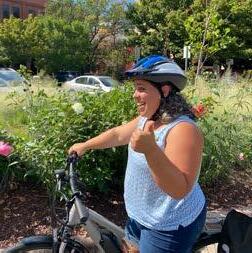



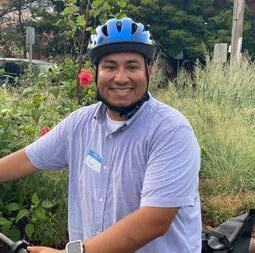

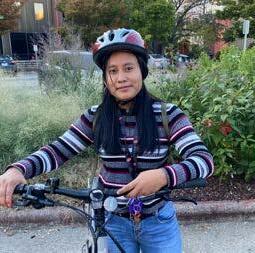
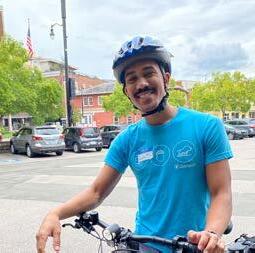



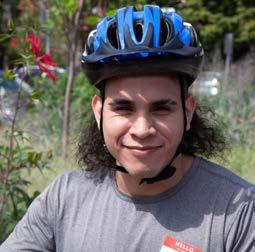

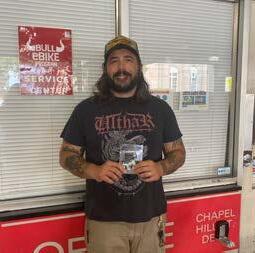
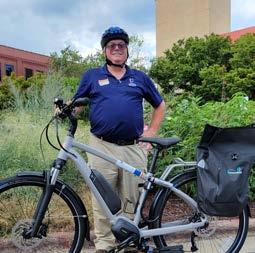
Through the Bull E-Bike Pilot Program, the City of Durham’s primary target audience was service-industry downtown workers. The City placed additional emphasis on measuring increases in mobility within transportation disadvantaged communities. To ensure that the pilot met those goals, the City set up a tiered applicant rubric, based on the following metrics. Full application scoring available in the Appendix.
Downtown Employee: Participants were required to work within the Downtown Durham, Inc. (DDI) Merchant Boundary, which includes the Golden Belt, Government Services, American Tobacco, City Center, Central Park, Warehouse, and Brightleaf Districts. Applications with work addresses outside the DDI area were not considered for this pilot. The below map shows the DDI boundary and all the businesses canvassed during outreach.

Income Considerations:
Applicants who have participated in any public assistance program in the past 12 months were automatically accepted into the pilot. Additionally, applicants from households reporting an annual income of $40,000 or less were given preference. Applicants were asked to self-report their annual household income and participation in public assistance programs through the Google Form Application.
Additional Priority Areas: Applicants who self-reported the following were given additional preference in application scoring:
★ Gender Identity: Preference to non-cis male
★ Race/Ethnicity: Preference to non-White/ Caucasian
★ Age: Preference to age 45+
★ Spoken Language: Preference to non-English speaking
Other Considerations:
Applicants who work from home, work as delivery drivers or are students, as well as applicants who reported low income levels, but above the $40,000 threshold, were flagged for preferential consideration. The applicant scoring method also considered:
★ Commute Distance: Used as a measure of the benefit of mode replacement
★ Proposed Frequency of Bike Use: Used as a measure of the commitment to using the e-bike
★ Familiarity and comfort level with biking: Used as a measure of barrier to entries
Participant applications were evaluated and scored by a review team of three City staff. All applications were scored on a rubric developed by program administrators (see Appendix). Applications were rolling, meaning there was no close date during the pilot, until the last Cohort 7 orientation on November 10th. In total, the City received 323 applications and accepted 61 participants.
Participants regularly shared their experiences with program administrators through weekly surveys and testimonials. Below is an introduction to a few of the pilot participants:
Nastacia Age: 25-30
Lives on a limited income, shares a car with a partner and typically uses carpool, vanpool or transit to commute to work.
Reflections on the Bull E-Bike Pilot:
“I don’t wanna overstate this, but I feel that it made me want to commute to work. I actually wanted to go to work because I was like, “oh, I get this 30 minutes to myself, to just think about whatever.” I also got to see my neighborhood in a different way, and bike sections of the American Tobacco Trail that I hadn’t before, and it made me feel a little bit more plugged into Durham. Over the last two years being in the pandemic, it really didn’t feel that I knew [Durham]. I go downtown, but not that often and I tried to avoid it as much as possible.”
Camryn Age: 31-35
Works as a beer auctioneer, lives on a limited income and typically walks to work.
Reflections on the Bull E-Bike Pilot:

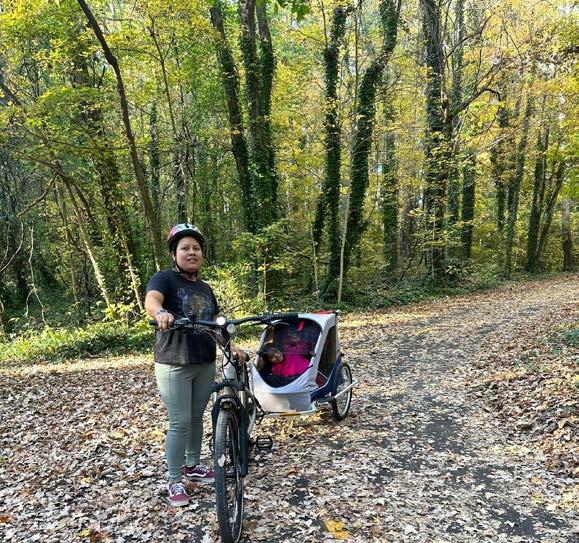


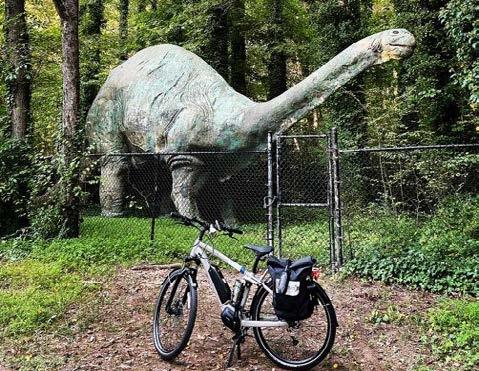

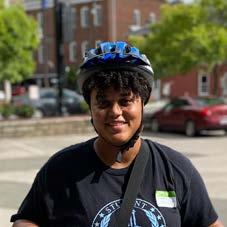
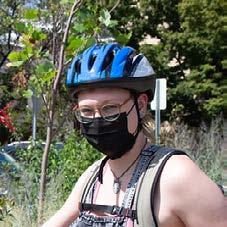
“So for me, I haven’t had a license or a car since sometime in college for medical reasons and this is the first time I’ve had reliable transportation that I could use and control independently. So it was literally the ability to go places downtown and I worked downtown so being able to pick up my meds and go to work without the help of a friend to drop me off or requiring like 30 minutes to an hour to walk somewhere.”
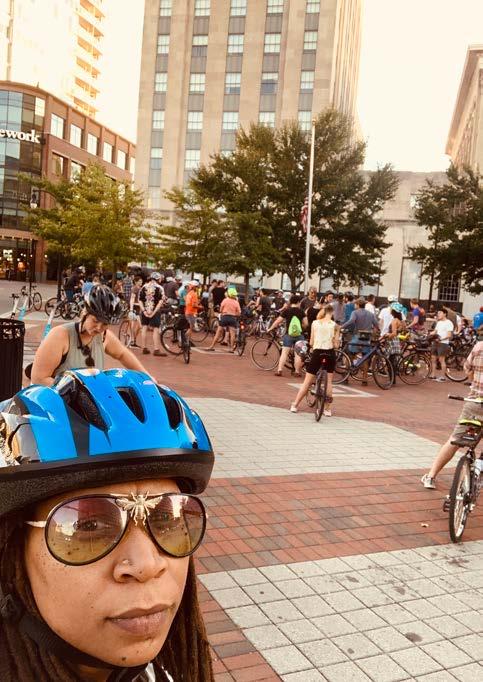
The City deployed a rolling application for the pilot, in order to maximize the reach of the program and work toward increasing the size and diversity of each cohort. Participant recruitment efforts included:
★ Advertised on all 55 GoDurham buses
★ One broken e-bike was temporarily placed in three different locations of downtown with a recruitment sign in English and Spanish
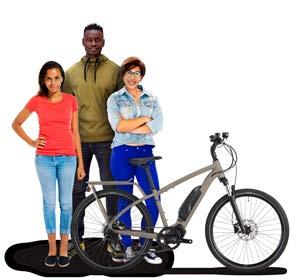
★ Bull City News created a video for the City to share with employees and social media channels
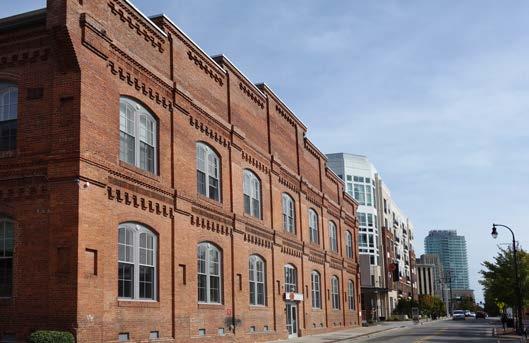
★ Tabled with an e-bike at a downtown festival
★ Developed social media content
★ Videography productions
★ Advertised the pilot through employees’ paper paychecks
★ Flyers posted at local businesses, in collaboration with Downtown Durham, Inc.
★ Canvassed door-to-door all 85 downtown Durham businesses (DDI map)
★ Participant referral bonuses of $100 if the recommended person was accepted to the pilot program
★ Tabled with an e-bike at Durham Station

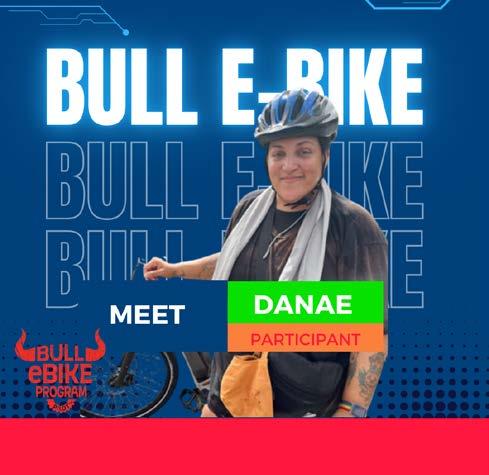
★ Email recruitment efforts through Bike Durham and DDI listservs
These recruitment efforts were particularly intended to recruit participants who are transportation-disadvantaged, and who work in downtown Durham in the service sector. This targeted effort was in alignment with the pilot’s equity focus. The advertisements on the buses helped to reach those who are reliant on public transportation, and the advertisements posted around local businesses further targeted those who work in service sector jobs in Durham’s urban core.

As one participant noted, “It was really cool that they went to specific businesses. They came to my restaurant, and they came to our sister restaurant across the way, too, so they definitely made a point to try to spread the word. And I told everyone I knew [about the program].”
Most of the recruitment tactics were effective, as each cohort had ample applicants. However, the most important recruitment tool was the word-of-mouth promotion that was driven by current and past participants and enabled by the open, rolling application period. This was encouraged by the referral bonus.
As one of our participants with children noted, “My bike was very popular at school drop off. Everybody had questions about the bike, so we talked about it a lot.” These e-bikes proved to be quite the conversation starter, and our participants generally were very satisfied with the program and promoted it to friends, family, and even complete strangers who were interested.
Another one of our participants said, “So many people would stop me while I was riding the bikes, to the grocery store, for example, and they said, ‘Oh my gosh, that’s such a cool bike what are you doing?’ And I’m like ‘Oh,
there’s this pilot, sign up for this, and people are super into it. I just don’t think that they knew about it.”
They went on to say, “I’ve been talking about this pilot to anyone who will listen.”
Throughout the duration of the pilot program, the team sought to be as accessible as possible with the participants if they encountered any challenges throughout their trial with the e-bike. Participants had access to a Google Form as a sticker QR code on each e-bike, where they could file a bike maintenance request, report issues with the OpenPATH phone app, or express any other concerns. In addition, participants filled out a weekly checkin form, where they could express any additional thoughts they had on the program, both positive and negative. Since this program was an active pilot, the team used participant feedback to adjust the program design each day. The team also had a mechanic present at the Bull E-Bike service center three days a week to deal with any technical issues with the e-bikes.
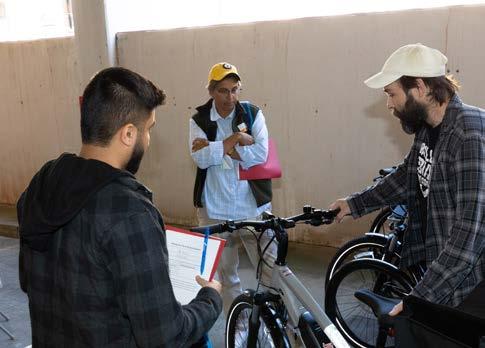
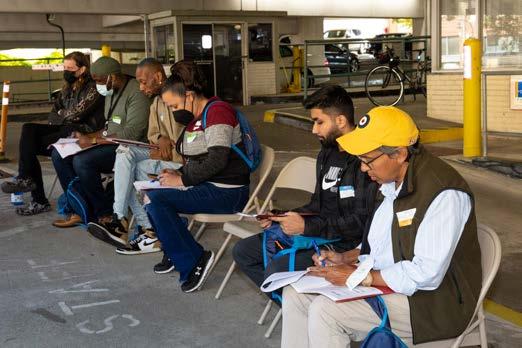
I’ve been talking about this pilot to anyone who will listen.
There were 6,452 total trips recorded for the pilot, confirmed by users or not. Of the 6,452 trips, 50.3% were confirmed. Of the 3,243 confirmed trips, 1,121 were made by e-bike. This means that roughly over a third (34.6%) of all confirmed trips by our participants were made using the e-bike.
The graphic below shows the e-bike was the most used form of transportation for our participants during the pilot. E-bike trips occurred over 10% more than driving alone.
34.6% Confirmed trips using e-bike
However, e-bike trips, although comprising 34.6% of all confirmed trips, only represented 15.0% of all distance from confirmed trips, or 2,933 miles. This discrepancy can be understood by looking at the distance per trip by transportation mode. E-bike trips averaged roughly three miles while ‘drove alone’ trips averaged around five miles per trip. Overall, we saw that the threshold for cycling trips seems to be around three miles, and that the average distance per trip is around 40% greater on the e-bikes compared to traditional, non-motorized pedal bikes, which is encouraging.
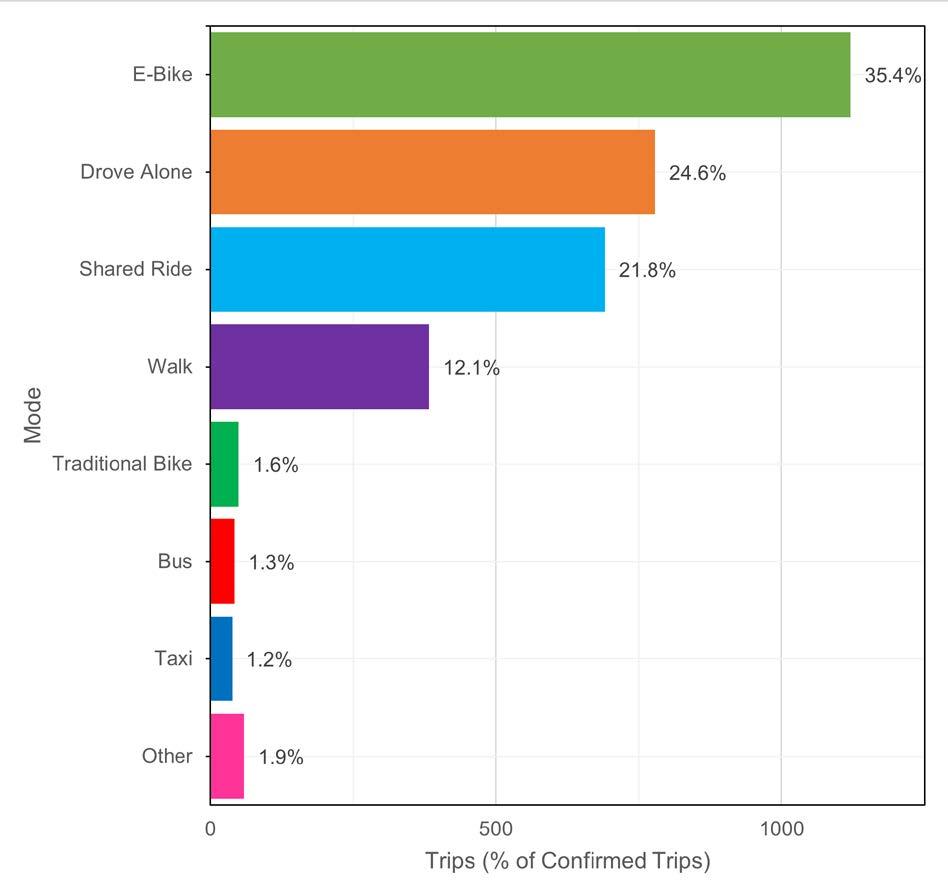
Distance of confirmed trips by mode is illustrated in the chart below:
The participants generally confirmed a larger number of trips and used the e-bike more at the beginning of their trial with the e-bikes, but we saw an uptick in both the confirmation rate and the e-bike usage toward the end of their trial as well. We assume that this trend is due to participants wanting to use the e-bike before they turn it back in, as well as a sentiment that some participants have expressed that they wanted to feel like a “good” participant before their trial ended.


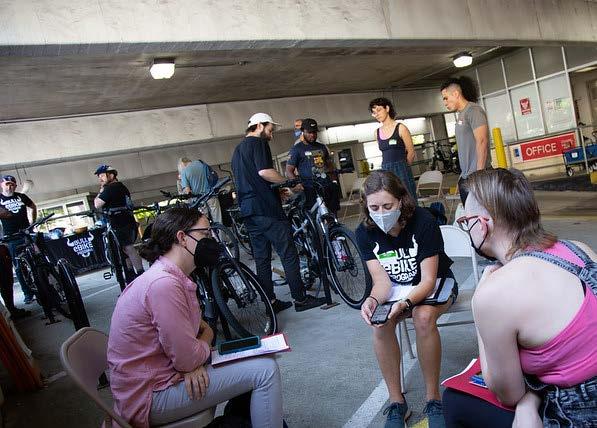
When evaluating Trip Purpose, where the confirmed mode was “e-bike,”the majority of trips were going to work/school or home (31.0% and 30.2%, respectively). However, a large number of trips were also made for exercise or socializing. This is derived from the 1,121 trips total where a purpose was confirmed. The bar graph below visualizes this.
It is worth noting that the percent of confirmed trips by e-bike were highest during the week, and were lowest during the weekend. This is in line with a typical Monday-Friday 9 to 5 work schedule, as we saw that the e-bikes received most of their use in commuting to work.
The pilot set out to replace single occupancy vehicle commutes with e-bike trips. Overall, 2,916 miles of travel were replaced by the e-bike. Of this, 1,099 miles of single occupancy vehicle travel were eliminated from 372 trips. The graph below shows the percent of distance replaced by the e-bike, grouped by the mode that the e-bike replaced.

As we can see, the e-bike pilot program was a success in replacing single occupancy vehicle trips and shared rides!
The City’s focus on shift workers is similarly reflected in the usage data, as shown in the graphs below. Peak commute hours are often seen between 7-9 and 4-6; however pilot participants were more likely to use the e-bike outside of these peak hours, with peaks at 11 a.m. and 4 p.m., and a general trend toward afternoon and evening travel, potentially corresponding to the type of work and when shift changes occur.

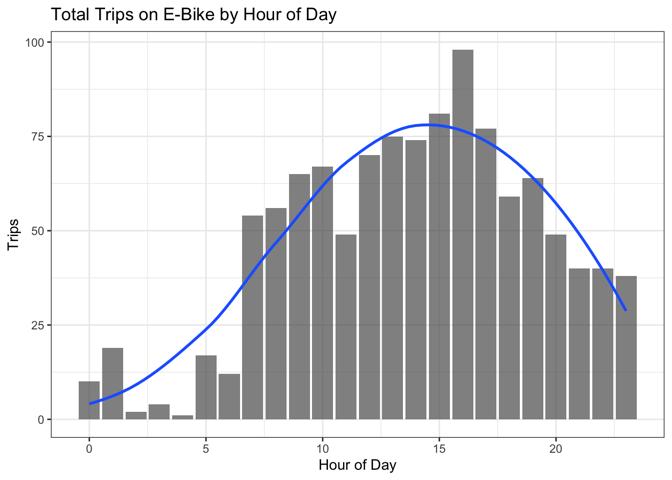
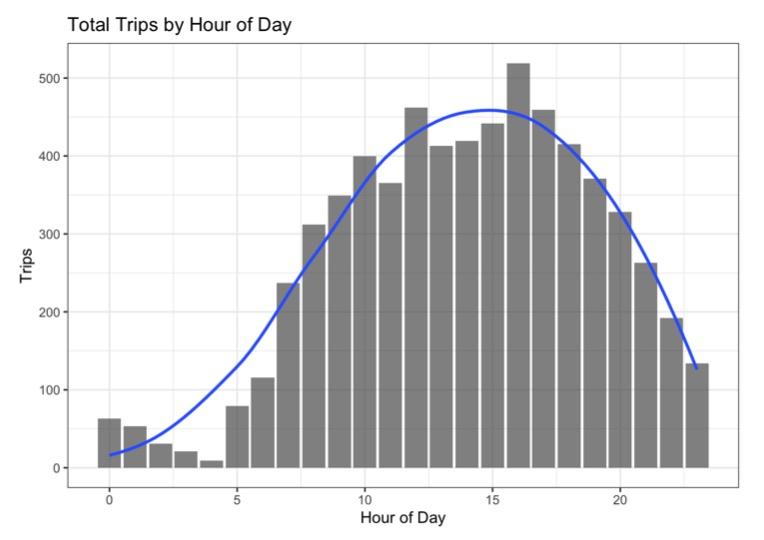
e-bike maintenance from the Bull E-Bike mechanic can be found in the Appendix. The most commonly occurring maintenance issues participants faced during the pilot were:

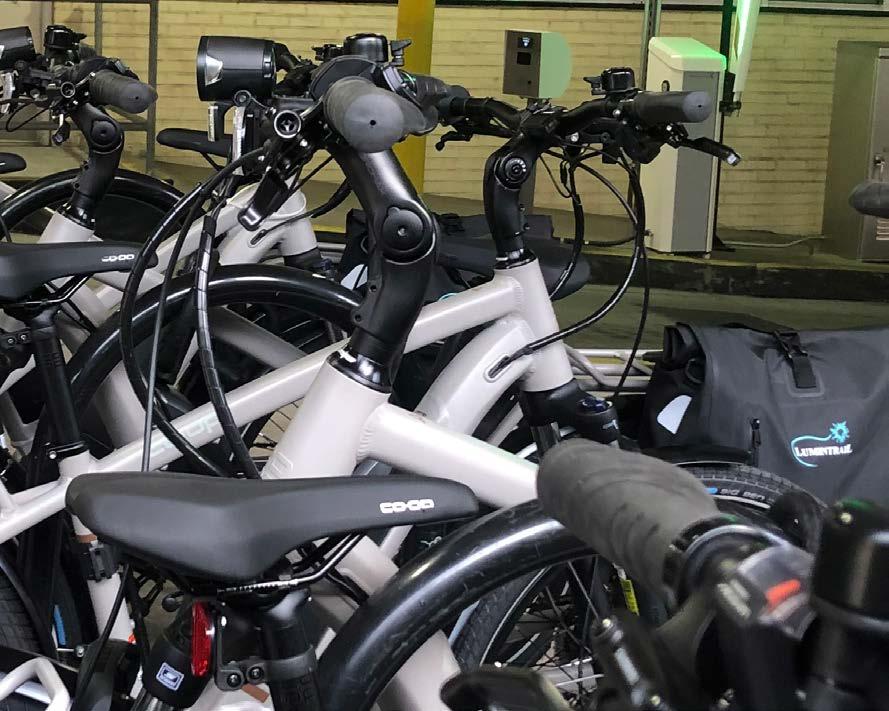
1. Drivetrain issues (including poor shifting, chain falling off, chain breaking, excess noise)
2. Error messages from the e-bikes’ electronic controller display
3. Headlights not working or being damaged
Additional mechanical issues included kickstands loosening and issues with the battery locks. Participants used a Google Form to log mechanical issues and the Bull E-Bike mechanic worked to quickly address these issues so that participants could get back on their e-bikes without missing too much time. Having an on-call bike mechanic qualified to work on e-bikes was an important part of keeping this pilot moving and keeping it affordable and comfortable for participants.

A full debrief of the qualitative data from participant feedback can be found in the Appendix.
Participants noted many benefits from the Bull E-Bike Pilot Program, including commuting benefits, independence, mode replacement and social/ community benefits.
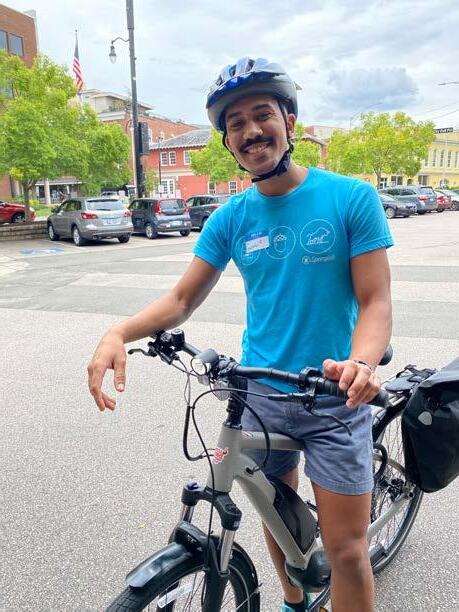
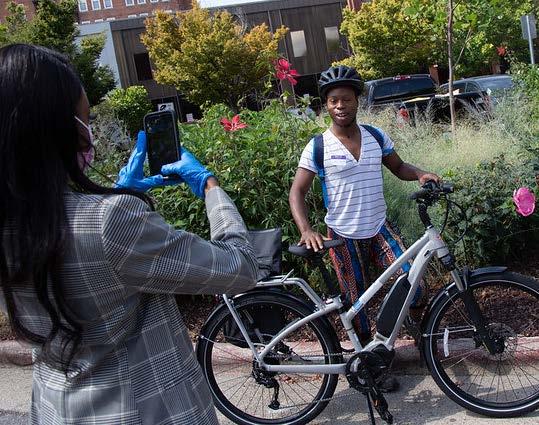
Participants took note of their increased focus at work after a commute and clarity of mind throughout the day. The program helped riders see the value in biking and how increasing access to biking can help the City. The program allowed people to see biking as a legitimate form of transportation and not just a tourist/recreational activity. Logging trips helped riders become more aware of their single occupancy vehicle trips. Many participants noted the benefit of being able to test an e-bike without having to invest large amounts of money before knowing if it would fit into their lifestyle. Several participants noted that the pedal assist allowed them to increase their comfort at work as they no longer had to show up sweating or deal with the hassle of bringing extra clothes to change into at work. Participants also mentioned the lack of concern for parking as a major benefit as well. In addition to saving time, participants saved money by not parking downtown with several mentioning the increasing development creating pressure on already scarce parking resources.
Quentin
“I definitely saved on parking and gas, money wise. I feel like there’s a lot of mental health benefits from not driving alone in a car because that just doesn’t feel good. To be able to bike instead and be outside was really nice. Especially on this bike where I’m not having to exert a lot of physical effort on my way to work so I wasn’t going into work already physically exhausted. I just feel like it increased my quality of life by a huge amount.”
Lena
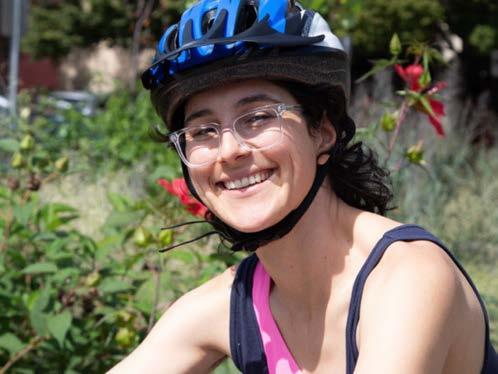
“I got to places quicker and was less fatigued.... It made me want to commute with my bike more because I knew I was gonna be able to do it without the stress of showing up to wherever I need to be drenched in sweat.”
Participants noted the change in commute habits led to more independence, especially those who commute by transit, traditional bike, or walk having a decrease in travel time. This decrease in commute time allowed some participants more time to spend running errands, trip chaining, exploring downtown and the American Tobacco Trail, or even more time with their pets in the morning. Some participants who noted particular benefits in independence shared a vehicle with their partners or had no car at all. One participant now had access to education while another could apply for a new job downtown now that they had reliable transportation access.
During the program most participants used the e-bike multiple times a week as indicated by their weekly check in surveys. Some current car owners replaced trips in their car with the e-bike completely: “I was able to replace almost 100% of car trips that I would have made with the e-bike instead. So that was really helpful.” (Lena). Participants still used their car for longer trips or to areas that did not have good biking infrastructure. Pedestrians
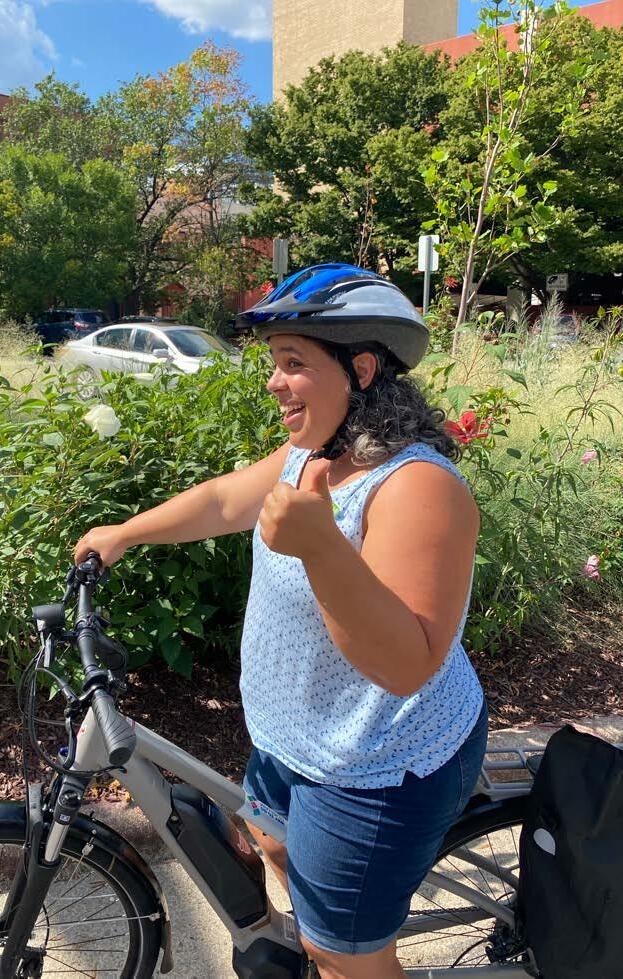
appreciated the shorter commute time as it helped them avoid long stints in poor weather. Participants who already owned a traditional bike did not see much change in how often they biked but noted that they enjoyed the ride more. Nearly every participant would like to continue biking (either motorized or non-motorized) after the program.
“ I was getting rides from people, coworkers. Around the time this program started the guy that I was getting rides from all the time had moved so it was not convenient for him to come and really get me any more. So this program came at the right time and it was just a really huge benefit for helping not having to rely on other people for transportation.”
-JosephMany participants noted the social benefits of biking. Some chose to join local biking groups or go on leisure rides with their friends. Having access to the e-bike increased mobility and increased the number of links within participants’ trips. Instead of going straight home, they would stay out to socialize downtown.
giving the e-bikes to the most in need riders and an e-bike share program. Some participants noted that a lack of storage space proved to be a challenge for them. Having access to an e-bike share program would solve this issue. For those who would like to own their own e-bike, users suggested a subsidy program or grants for residents. Given the number of riders interested in buying an e-bike, participants would benefit from education about where and how to buy an e-bike and any subsidies available.
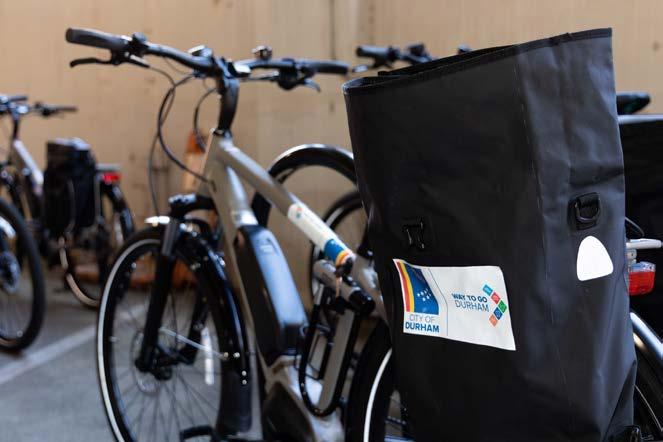
When considering the future of the e-bikes currently in the City of Durham’s possession, participants suggested several ideas including
The majority of participants liked the model of the e-bike. The motor worked well for most people although some experienced mechanical issues that further shortened the time they could get accustomed to and ride the e-bike. While the City provided a waterproof pannier, several participants noted a desire for more storage space, such as a cargo bike for bigger trips like grocery shopping or a bike that they could ride safely with their children (although several participants attached a trailer to the back of the e-bike to carry their kids!). Numerous participants also noted the weight of the e-bike with respect to loading it onto a bus or maneuvering up stairs into their home. Most participants noted the benefits of the accessories provided with the e-bike, including
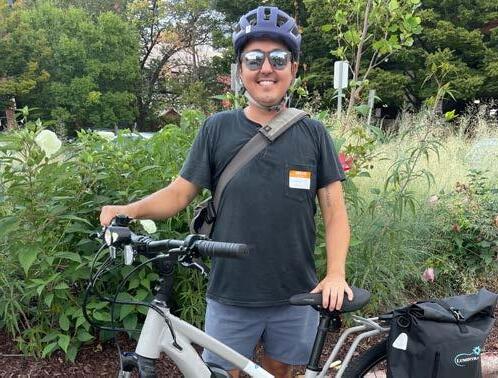
“It definitely made me connect with some people more throughout the week than I normally would and kind of go and stay longer too like downtown.
- Braedyn
the lights, racks, and pannier. Nearly all participants said cost is a factor in considering using an e-bike in the future. Future versions of this program should consider using various types of e-bikes to facilitate different user needs (cargo, etc.), as well as storage and security needs.
Many participants recognized the value of using a cohort model to maximize the number of people able to use the e-bikes, though nearly all participants expressed a desire to use the e-bike for a longer period of time, with some noting the time needed to change longstanding travel patterns and establish new routines. Multiple participants also expressed the desire to connect with other members of their cohort throughout the program. Future versions of this program should consider the timing of their cohorts and potential group rides or other methods of offering connections between participants in the program.
Many riders thought the weekly check-ins were too frequent and repetitive. Analysis of the weekly check in data verified this as participants gave short answers with little substantive information as respondents clearly found little interest in the survey. The City designed the check-ins for dual purpose: data gathering and accountability/communication. The check-ins did not ultimately provide extensive qualitative data, and it is difficult to measure their impact on accountability. As seen in the Quantitative Data Analysis, user app engagement dipped in the middle weeks for each cohort, so it is possible that these check-ins did not provide extra encouragement or accountability for participant app engagement. Future versions of this program should evaluate the need for and design of check-ins based on the goals of data gathering versus accountability.
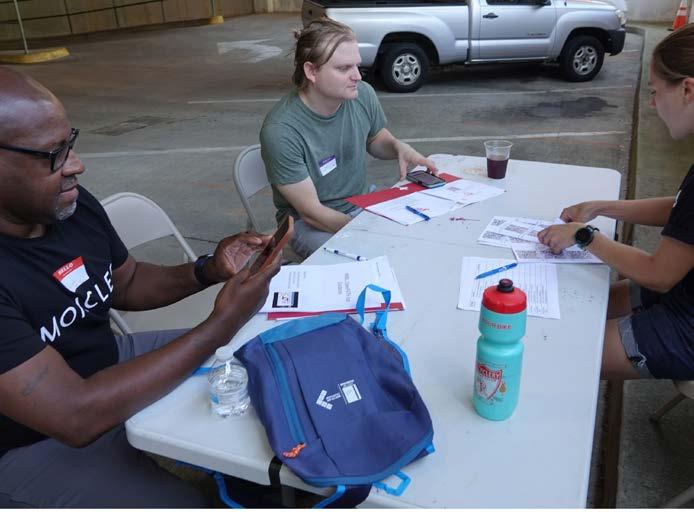
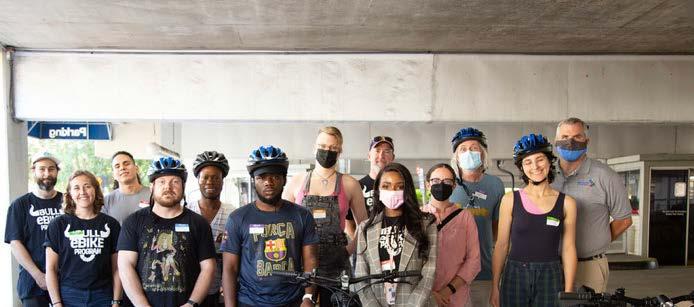
The Bull-E Bike Pilot has encountered moments throughout its implementation where pivoting was necessary to ensure the continued success of the program. One of these moments was the City of Durham’s decision to switch from the pre-owned e-bikes to purchasing a fleet of new e-bikes from REI. The pilot program was initially designed to be much larger in scale with the help of 500 used e-bikes obtained by the City of Durham from a thirdparty vendor. However, a decision was later made to not incorporate the used e-bikes into the pilot due to substantial variations in bike quality and the associated concerns regarding participant safety.
Since the pivot needed to be completed within two months before the pilot began, the process presented a time-sensitive challenge to the implementation team. The decision to purchase about 50 e-bikes from REI was made after weeks of intensive research on how best to acquire high-quality e-bikes that can be delivered in an efficient manner at the lowest possible cost. The pivot experience offered the team a valuable lesson on how to tackle unexpected changes that emerge during the
implementation process, which can be a vital skill set whendesigning and leading a ground-breaking pilot program for the City.
Based on this experience, it is recommended that other municipalities seeking to conduct a similar program should consider sourcing new e-bikes rather than used fleet vehicles previously owned by another private entity or organization. This is due to the typically stringent legal responsibilities that cities are required to shoulder when conducting such a public program and the uncertain nature of the used e-bikes’ quality as they are retired from the existing commercial fleet. The purchasing of new e-bikes from retailers could be the solution for a small-scale pilot program when the municipality has the funding to cover the expenses, as this method could ensure the quality and uniformity of the e-bikes available to program participants.
Additionally, the City pivoted to the “super-user” model (defined in Cohort Model) after noticing that data compliance was lower than anticipated. This pivot was designed to incentivize compliance and data entry.
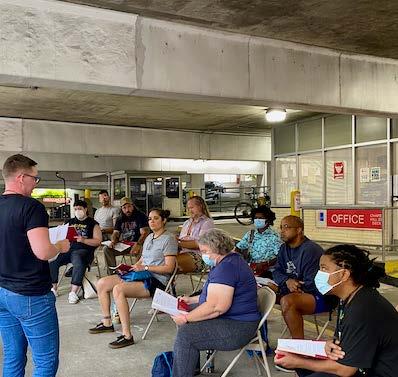
Participants in the program expressed great appreciation for the opportunity to experience Durham in a different way, a change in their views on single occupancy vehicle travel, and a desire to continue biking in the future. Pedestrians and car owners were most likely to see significant changes in their travel patterns, and participants without regular access to a vehicle were most likely to use the e-bike for the majority of their trips.
The City’s Department of Transportation set out to deliver a new mode of transportation to shift workers in downtown Durham, and over the course of the pilot delivered on this goal
for a diverse group of Durham residents. The preliminary findings in this report and the associated appendices show trends in reducing carbon emissions, increasing mobility, improving health and wellbeing and providing economic relief. While Durham continually works to improve the education and safe connectivity opportunities across the City, the Bull E-Bike Pilot Program has shown there is an appetite for these improvements and for adoption of non-vehicular transportation modes.

Appendix A: Phase I - Marketing & Recruitment
Promotional Materials
★ Bus Recruitment Poster
★ Recruitment Postcard
★ Recruitment Postcard (Spanish)
★ Social Media Handles Flyer
★ Social Media Spotlight Flyer Engagement Report
DDI Boundary Map including 85 canvassed businesses
Pilot Participant Application
★ English
★ Spanish
Applicant Scoring Rubric
Application Status Email Scripts
Spanish Acceptance Email Script
Appendix B: Phase IIImplementation
Onboarding Materials
1. Agenda
2. Participation Requirements (Spanish version here)
3. Participant Waiver and Consent Form (Spanish version here)
4. Photography Release Form (Spanish version here)
5. City Property Receipt (Spanish version here)
6. Participant Expectations (Spanish version here)
7. Benchmark Survey (Spanish version here)
8. App Setup Instructions
9. App Guidance (Spanish version here)
10. Contact Us Guidance
11. Promotional Materials
12. Customized commute routes, made via Google Maps
Team Contact Form
Participant Resource Page
Participant FAQs
Weekly Check-in Form
★ English
★ Spanish
Participant Communications
★ English
★ Spanish
Video Recruitment Email Script
Return Bike Letter
Appendix C: Phase III - Evaluation
Bike Maintenance Report
Key Performance Indicators (KPIs)
Percentage of Trips Confirmed Quantitative NREL App Trip Confirmation data in app
Frequency of Riding Quantitative NREL App Rides per weekTemporal shift in rides per weekDemographic analysis
Mode Shifting Quantitative NREL App Mode selectedDuration/DistanceDemographic analysis
Trip Purpose Quantitative NREL App Move v. Purpose - Temporal shift in mode v purposeDemographic analysis
Weather Conditions Quantitative NREL App, Weather Tracking Daily frequency v weather conditionsDemographic analysis
Rider Confidence Qualitative Benchmark survey, closing survey, NREL App
Confidence scale across surveysTemporal shifts in trip frequency and duration change
E-Bike Stickiness Qualitative Closing survey, benchmark survey Barriers to owning e-bike - Motivations v. benefits of program
Transportation Access Qualitative NREL App, closeout survey Trip generationWillingness to use noncar travel
Social Opportunity Qualitative Closeout survey Benefits of using an e-bike
Determines quantitative data confidence levels
Determines e-bike adoption rate by time and social equity
Determines mode shifting and environmental impact by time, distance and social equity
Determines trip mode choice by purpose, compared over time and by social equity
Applies weather-based filter on quantitative data; determines weather impact on ridership
Determines change in rider confidence levels
Determines likeliness of e-bike adoption in participants
Determines access to transportation alternatives
Identifies social mobility as a result of pilot
Economic Opportunity Qualitative Closeout survey Benefits of using an e-bike Identifies economic mobility as a result of pilot
Health Opportunity Qualitative Closeout survey Benefits of using an e-bike
Identifies health mobility as a result of pilot
Qualitative Data Summary
Quantitative Data Summary
